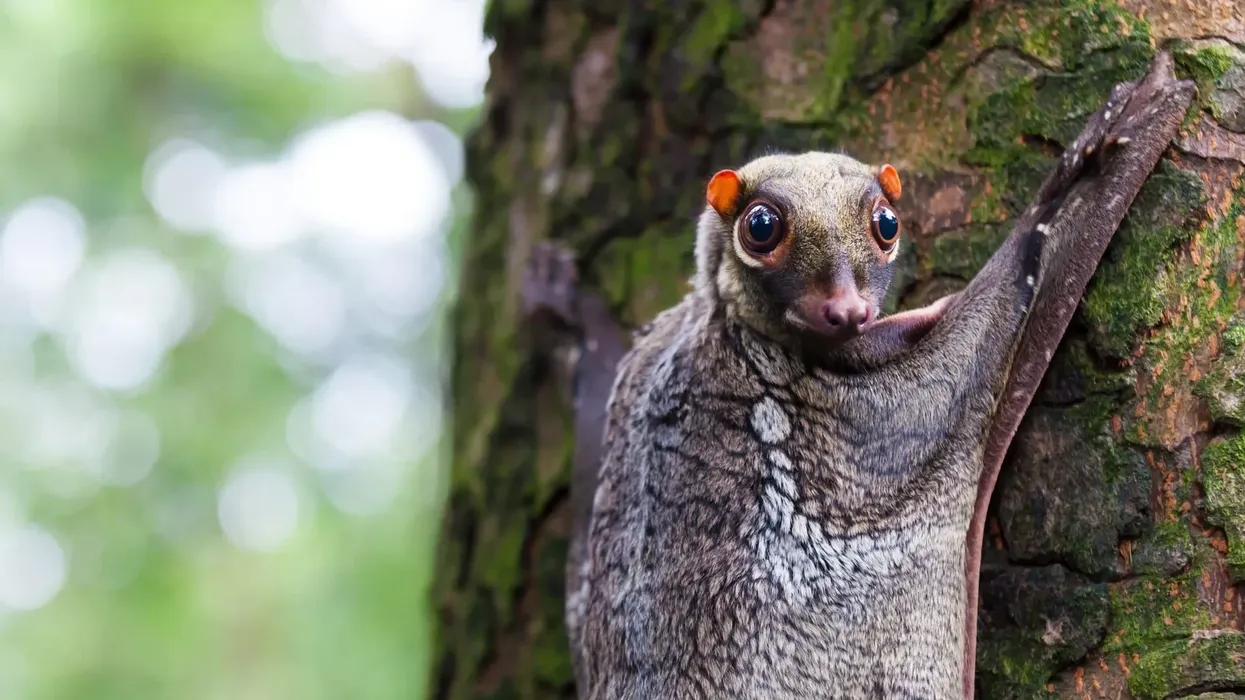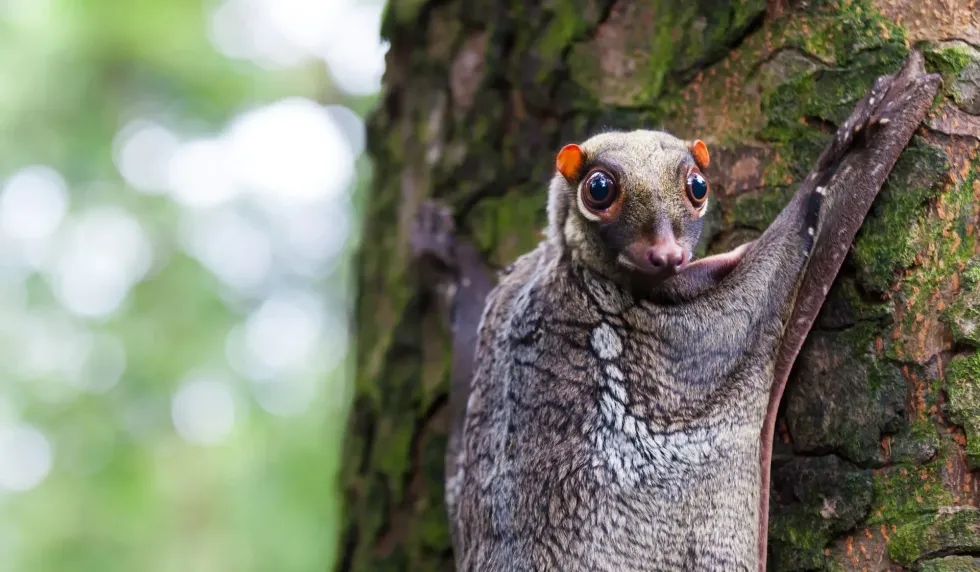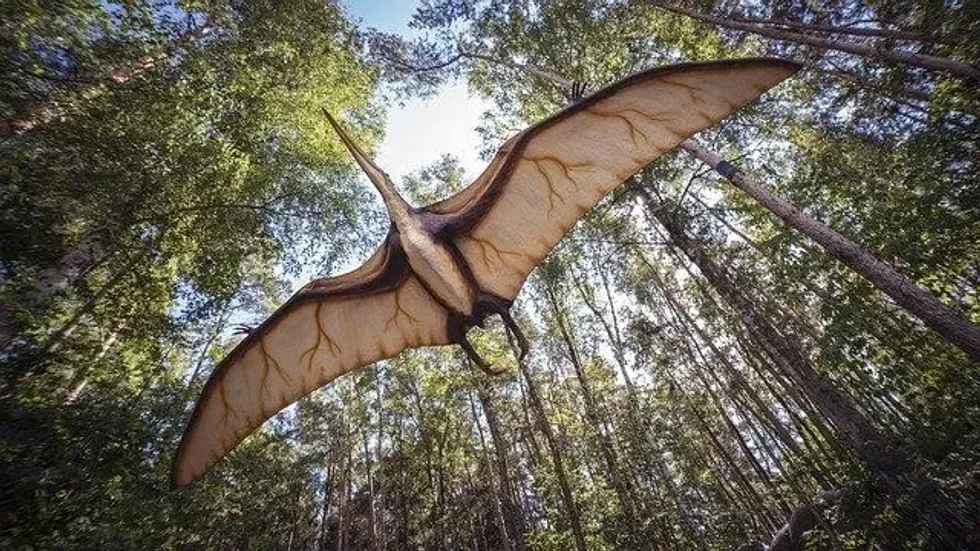Colugos, also known as flying lemurs, are a type of arboreal gliding mammal. They are native to SouthEast Asia and are usually found in tropical rainforests. They are tree-dwelling mammals.
There are two known species of colugo found in the words, and they include Sunda flying lemur (Galeopterus variegatus) and Philippine flying lemur or Cynocephalus volans. Both these belong to the order Dermoptera.
What is interesting to see here is that they are not at all related to either lemur or can they fly. Because of their body structure and the adaptation to gliding, they were believed to be related to bats. However, it was later found out that their morphology is more closely related to primates.
Both the colugo species are known as two of the most capable gliding mammals in the world with small, sharp claws. What gives them the ability to glide in the air up to 656.1 ft (200 m) is a membrane that connects its face, paws, legs, and tail.
They are nocturnal animals and are often very hard to find. They are often seen on the trees because they are helpless to predators on the ground. These flying lemurs with excellent binocular vision usually live alone or in small groups.
In 1995, a fossil impression of a giant colugo was found that showed its membranous wings stretching from its wrists to its ankles. This led to the scientists believing that they could swim. But, in early 1997, they found that colugo swimming was not possible.
Included in this article is information regarding hairless colugo, colugo skeleton, colugo diet, colugo in captivity, and more!
Also, if you want to know more such facts about mammals, then check out proboscis monkey facts and macaque monkey facts.
Colugo Interesting Facts
What type of animal is a colugo?
Colugos species are types of tree-dwelling or arboreal mammals with slender limbs. They also fall under the categories of gliding mammals.
What class of animal does a colugo belong to?
Colugo or the Malayan colugo belongs to the class Mammalia and the order Dermoptera.
How many colugos are there in the world?
Since colugos are very shy creatures, their number has not been identified. However, they are considered as of Least Concern by IUCN. However, the species find threats because of the ongoing deforestation since trees are their natural habitat.
Where does a colugo live?
Colugo lives in the Tropical Rain forests. They are known as Sunda flying lemur, or Galeopterus variegatus, in South East Asian countries such as Malaysia, Thailand, Indonesia, Southern Burma, and Singapore. In the Philippines, they are known as Philippine flying lemurs or Cynocephalus Volans.
What is a colugo's habitat?
Both the colugo species or the order Dermoptera, are tree dwellers and their habitat is tropical rain forests of southeast Asia. They are also found on some Philippine Islands.
Both of these species are arboreal and hence they live on the trees and rarely come down to the ground. They usually sleep on the trees making their home within the holes or dense foliage on them. They are also seen clinging to the tree trunks or the underside of tree branches.
Who do colugos live with?
Colugos are solitary in nature and hence they usually prefer to live alone. However, they are also sometimes seen living in groups.
These groups are usually loosely knit because they become easily territorial about their sleeping branch or food. Hence it is not very common to find these flying lemurs near each other very often except for when they are breeding. The females however carry their children with them until they grow up.
How long does a colugo live?
Just like any other mammal that is the size of a colugo, they also live for about 10-13 years. The lifespan of these flying lemurs can differ from place to place.
How do they reproduce?
There is not much information about the reproduction of flying lemurs or Sunda flying lemurs. However, they do reproduce sexually and give birth to one baby at a time.
They can also have twins sometimes but the litter never gets bigger than that. The breeding season for the flying lemurs is not specified. This means that they breed throughout the year.
The Sunda flying lemur carries the young with them for six months. The young or juvenile is solely dependent on their mothers for this period of time and are seen clinging to their mothers for six months. However, they only reach full maturity after two years.
What is their conservation status?
The conservation status for these flying lemurs as per the IUCN is of Least Concern. However, it has been seen that these colugo gliding mammals are prone to be hunted for meat and fur.
Since they are pretty much defenseless when not on top of a tree, humans have threatened their existence for a long time. In addition to this, the Sunda colugo population is also threatened by the Philippines Eagle which is the most dangerous predator for these gliding colugos.
Colugo Fun Facts
What do colugos look like?

Colugos, of the order Dermoptera, usually look like lemurs because of the structure of their head and their big protruding eyes. Along with this, they also have teeth that are similar to lemurs that are shaped as combs.
Their other characteristics include a fur skin-covered membrane which is also called a patagium, slender limbs, and small, sharp claws. This patagium connects their tail, feet, hands, and face.
This thin membrane is what helps colugos glide. They usually have black, gray, red, or white fur skin-covered membranes that are often littered in dots and can be easily identified.
They have excellent binocular vision and their webbed feet give them an appearance as a bat. Also, the dentition on the colugo skull is unusual.
The lower incisors of colugo teeth split into tine-like forks that give the appearance of a hair comb. Also, they don't have upper incisors, only a ridged palate.
How cute are they?
Colugo can not be considered cute. However, people who find lemurs and bats cute might say that these gliding mammals are cute.
How do they communicate?
It was found that colugo animal communicates through sound frequencies just like the bats. Since they are mainly nocturnal, they communicate with sound frequencies.
How big is a colugo?
The length of a colugo species is between 14-16 in (35.5cm-40.6 cm). Sunda colugo is usually the size of a large squirrel or a medium-sized rabbit. They can also be compared to the size of a fruit bat.
How fast can a colugo move?
Colugos are very slow on the ground but they are fast climbers. They can also glide easily from tree to tree at a height of 656.1 ft (200 m).
How much does a colugo weigh?
Colugos weight can be anywhere between 2.2 - 4.4 lbs (1- 2 kg) and there is no distinct difference between males and females of the species.
What are the male and female names of the species?
The males and females are called by the same name.
What would you call a baby colugo?
The baby colugo lemur does not have a name. They are just called infants or young.
What do they eat?
Colugos are herbivores and hence their diet includes fruits, leaves, roots, and anything they can find on the trees.
Are they aggressive?
Colugos are not aggressive per se, but they can be territorial for their food and living space.
Would they make a good pet?
No. They are wild animals and do not make good pets.
Did you know...
While traveling along branches or feeding, colugos hang upside down.
Types of colugos
There are two species of colugos. One is found in Southeast Asia and called Galeopterus variegatus and the other is found in the Philippines and called Cynocephalus volans.
Can colugos fly?
Not technically but they can glide from tree to tree.









